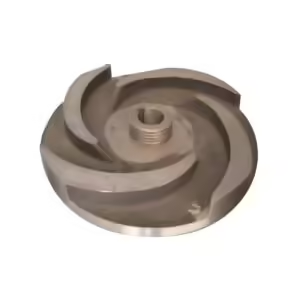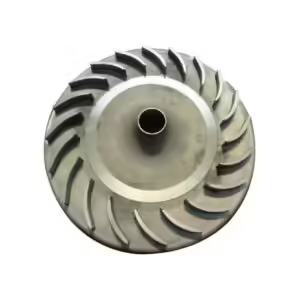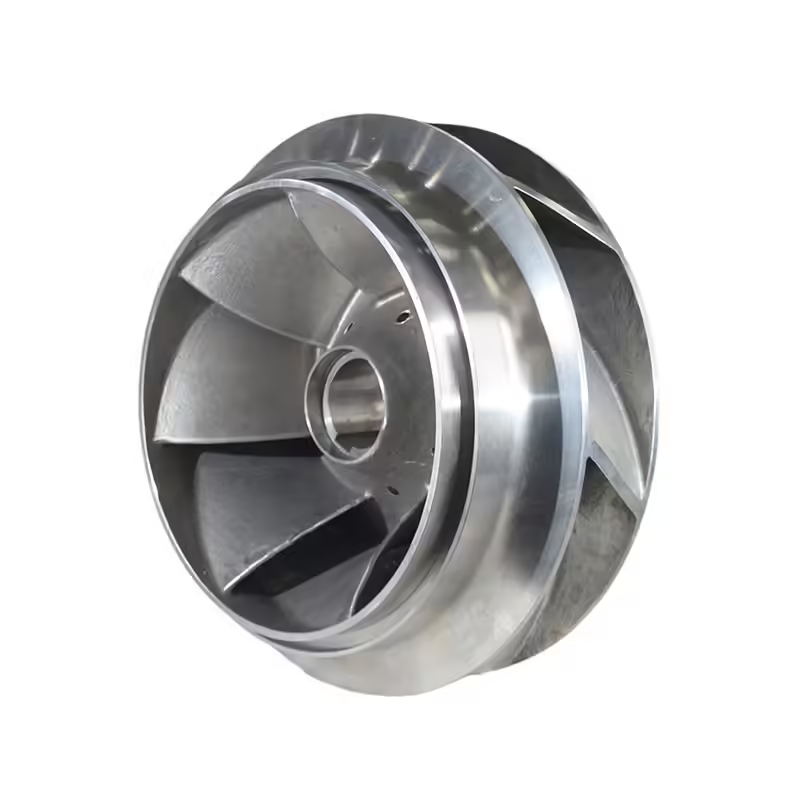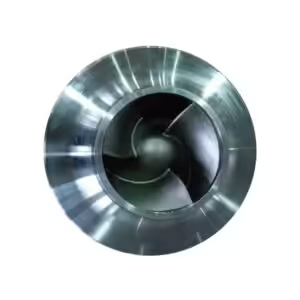5 señales impactantes de que necesitas reemplazar el impulsor de la bomba de agua
¡Bienvenido a mi blog!
¡Me encanta tenerte aquí! Antes de profundizar en el contenido, me encantaría que me acompañaras en mis redes sociales. Es donde comparto información adicional, conecto con nuestra increíble comunidad y te mantengo al tanto de las últimas noticias. Así es como puedes mantenerte conectado:
📘 Facebook: Shanghai Leierwo Industria Comercio Co., Ltd.
¡Ahora, emprendamos este viaje juntos! Espero que el contenido aquí te resulte no solo revelador, sino también inspirador y valioso. ¡Comencemos!
Tabla de contenido
Introducción


Cuando se trata de mantener la eficiencia de su sistema de enfriamiento o transferencia de fluidos, impulsor de la bomba de agua Es un componente crítico que a menudo pasa desapercibido hasta que falla. El impulsor de una bomba de agua desempeña un papel vital en la circulación del refrigerante o agua por el motor o sistema, garantizando la regulación de las temperaturas y el correcto funcionamiento de los procesos. Este proceso es especialmente importante en aplicaciones como motores de automóviles, maquinaria industrial y sistemas marinos. El impulsor, que suele estar fabricado con materiales duraderos como acero inoxidable o aluminio, ayuda a mantener la circulación del agua para evitar el sobrecalentamiento. Sin embargo, con el tiempo, el desgaste, la corrosión o la acumulación de residuos pueden dañar el impulsor.
Cuando esto sucede, el sistema puede empezar a fallar, lo que provoca problemas de rendimiento o, en el peor de los casos, un fallo total del sistema. En este artículo, analizaremos cinco señales alarmantes que indican que necesita un... impulsor de la bomba de agua reemplazo y por qué es esencial actuar a tiempo para evitar reparaciones costosas o averías del equipo.
Señal #1 – Sobrecalentamiento del motor o sistema
Una de las señales más alarmantes y claras de un impulsor de bomba de agua defectuoso es el sobrecalentamiento. Si las aspas del impulsor están desgastadas, rotas u obstruidas, no pueden circular el agua eficientemente. Esta reducción del caudal puede provocar que el motor se sobrecaliente rápidamente, especialmente bajo cargas pesadas o en ambientes cálidos. El sobrecalentamiento continuo no solo afecta el rendimiento, sino que también puede provocar daños a largo plazo en los componentes, como cabezales deformados, sellos dañados o incluso fallas graves del motor. Detectar el sobrecalentamiento a tiempo puede evitar reparaciones costosas.
El sobrecalentamiento del motor o de los sistemas indica un problema grave con el impulsor de la bomba de aguaSin una circulación de agua adecuada, la refrigeración es insuficiente, lo que provoca que el motor se sobrecaliente. Si nota un aumento de temperatura en el sistema, es fundamental inspeccionar el impulsor. Si falla, reemplazar el impulsor de la bomba de agua podría evitar daños mucho más costosos a largo plazo.
Señal #2: Ruido inusual durante el funcionamiento
Un ruido inusual de rechinamiento, chirrido o traqueteo proveniente de la bomba de agua puede indicar que el impulsor de la bomba está dañado o suelto. Dado que el impulsor gira a alta velocidad, cualquier desalineación o daño suele causar síntomas auditivos perceptibles. Esto es especialmente cierto en aplicaciones marinas y automotrices, donde la precisión y el equilibrio son cruciales. Estos ruidos deben motivar una inspección inmediata y, posiblemente, el reemplazo del impulsor de la bomba de agua para evitar una falla catastrófica.
Si el impulsor está dañado, el ruido puede indicar que las aspas están golpeando la carcasa de la bomba u otros componentes. Estos ruidos suelen ser consecuencia directa de un impulsor roto o muy desgastado, que ya no funciona eficientemente. Retrasar el reemplazo del impulsor de la bomba de agua podría provocar una falla total del impulsor, lo que dejaría el sistema inoperativo.
Señal #3: Disminución del flujo o la presión del refrigerante
Si ha notado una mala circulación del refrigerante o una presión de agua débil, el impulsor de la bomba de agua Puede ser la causa principal. Los álabes del impulsor agrietados, erosionados o dañados de cualquier forma no impulsarán el agua con la misma eficacia, lo que reduce la presión y el caudal del sistema. Esto puede provocar una refrigeración ineficiente y un menor rendimiento del motor. En sistemas que dependen del movimiento constante del fluido, un impulsor deteriorado supone una pérdida significativa de funcionalidad.
Un flujo deficiente de refrigerante o una presión reducida podrían indicar que el impulsor está a punto de fallar. Reemplazar el impulsor de la bomba de agua restablecerá el flujo necesario, garantizando que el motor o el sistema funcionen correctamente sin sobrecalentamiento. Un flujo irregular o una presión baja pueden causar daños prolongados al motor, por lo que es esencial reemplazarlo pronto.
Señal #4 – Desgaste o daño visible en el impulsor

La inspección física del impulsor puede proporcionar evidencia visual de deterioro. Busque señales como álabes rotos, corrosión, grietas o acumulación excesiva de residuos. Estos daños pueden obstaculizar el flujo de agua e indicar la necesidad urgente de reemplazar el impulsor de la bomba de agua. Las revisiones de mantenimiento periódicas y las inspecciones visuales son prácticas esenciales, especialmente en sistemas industriales o marinos donde el tiempo de funcionamiento es crucial.
Al realizar una inspección visual, asegúrese de que el impulsor esté intacto y libre de residuos acumulados. Si las aspas muestran signos de agrietamiento o erosión, o si están obstruidas con materiales, es evidente que... impulsor de la bomba de agua Es necesario reemplazarlo. Dejar que un impulsor dañado siga funcionando solo agravará el problema y, con el tiempo, provocará una falla total del sistema.
Señal #5: Apagados o alarmas frecuentes del sistema
Los sistemas modernos suelen venir equipados con sensores de advertencia que detectan condiciones de funcionamiento anormales. Si experimenta paradas frecuentes, códigos de error o señales de alarma, el impulsor de la bomba de agua podría ser el responsable. Un impulsor defectuoso interrumpe el ciclo del fluido, activando mecanismos de seguridad para evitar daños mayores. Estas alertas recurrentes nunca deben ignorarse, ya que pueden indicar directamente la necesidad de reemplazar el impulsor de la bomba de agua.
Un impulsor sobrecargado puede provocar alarmas del sistema o apagados automáticos diseñados para protegerlo de daños mayores. Si su sistema se apaga repetidamente o muestra códigos de error, es probable que... impulsor de la bomba de agua Ya no se puede mantener el flujo necesario de refrigerante. En tales casos, se debe priorizar el reemplazo del impulsor de la bomba de agua para restablecer el rendimiento óptimo del sistema.
Tabla de referencia de punto medio: comparación rápida de síntomas
| Síntoma | Posible problema con el impulsor | Acción recomendada |
|---|---|---|
| Calentamiento excesivo | Cuchillas desgastadas o rotas | Reemplace el impulsor inmediatamente |
| ruido inusual | Impulsor suelto o desalineado | Inspeccionar y reemplazar si es necesario |
| Baja presión de refrigerante | Paletas agrietadas o erosionadas | Confirmar el diagnóstico y reemplazar el impulsor |
| Daños visibles en el impulsor | Desgaste físico o corrosión | Reemplazar durante el mantenimiento programado |
| Alarmas frecuentes del sistema | Ciclo de fluidos interrumpido | Realice una verificación completa del sistema y reemplácelo |
¿Por qué es oportuno? Impulsor de la bomba de agua Asuntos de reemplazo
Reemplazar el impulsor de la bomba de agua con demora puede provocar problemas graves: desde una pequeña pérdida de rendimiento hasta una falla catastrófica. Reemplazar el impulsor con prontitud garantiza:
- Flujo de refrigerante constante para el control de la temperatura
- Prevención del sobrecalentamiento del motor o del sistema
- Eliminación de ruidos y vibraciones anormales de la bomba
- Reducción del tiempo de inactividad y de los costes de mantenimiento
- Mayor vida útil de su motor o equipo
Ya sea que opere un motor automotriz, maquinaria industrial o una embarcación marina, programar el reemplazo del impulsor de la bomba de agua tan pronto como aparezcan los signos es esencial para un rendimiento óptimo.
Cómo elegir el impulsor de repuesto adecuado

Al comprar un impulsor de repuesto, tenga en cuenta estos factores:
- Material:Acero inoxidable o bronce para resistencia a la corrosión, plástico reforzado para trabajos más livianos.
- Mueble:Especificaciones OEM exactas de diámetro, número de cuchillas y tipo de eje
- Calidad: Busque fabricantes certificados para garantizar la durabilidad y compatibilidad.
Consulte el manual de su equipo o a un técnico de confianza para obtener piezas de repuesto adecuadas para el impulsor de la bomba de agua.
Causas comunes de falla del impulsor
Comprender las causas de las fallas del impulsor puede ayudar a prevenir problemas futuros. Las causas comunes incluyen:
- Residuos en el sistema de agua o refrigerante
- Entornos operativos corrosivos
- Cavitación debido a bajos niveles de líquido
- Instalación o elección de material incorrecta
Las medidas preventivas, como instalar filtros, realizar inspecciones periódicas y garantizar condiciones de funcionamiento adecuadas, pueden contribuir a prolongar la vida útil del impulsor.
Mejores prácticas de mantenimiento preventivo
Para reducir la frecuencia de impulsor de la bomba de agua reemplazo, implemente estas mejores prácticas:
- Inspección regular:Verifique el estado del impulsor durante el mantenimiento de rutina.
- Limpieza del sistema:Elimine los residuos y el refrigerante viejo para evitar obstrucciones.
- Refrigerante de calidad:Utilice el refrigerante recomendado por el fabricante con inhibidores de corrosión.
- Instalación del filtro:Agregue filtros en línea para atrapar partículas antes de que lleguen a la bomba.
La adopción de estas medidas contribuye a una mayor vida útil del impulsor y a reducir los reemplazos de emergencia.
Conclusión
Un fracaso impulsor de la bomba de agua Al principio, puede parecer engañosamente silencioso, pero ignorar las señales puede provocar fallas mecánicas graves. Al comprender los síntomas, las causas y las respuestas adecuadas, estará mejor preparado para abordar los problemas de forma proactiva. Las revisiones periódicas y el reemplazo oportuno del impulsor de la bomba de agua son clave para mantener el rendimiento, la seguridad y la rentabilidad en cualquier sistema basado en fluidos.
PREGUNTAS FRECUENTES
¿Con qué frecuencia debo reemplazar mi impulsor de la bomba de agua?
Depende de la aplicación, pero la mayoría de los expertos recomiendan revisar o reemplazar el impulsor cada 1 o 2 años en sistemas marinos o de alto uso.
¿Puedo reemplazar el impulsor yo mismo?
Sí, si tiene conocimientos de mecánica y sigue las instrucciones adecuadas. Sin embargo, se recomienda un servicio profesional para sistemas complejos.
¿Qué materiales son los mejores para los impulsores?
Acero inoxidable para mayor durabilidad y resistencia a la corrosión, o plástico reforzado para usos rentables y con menor estrés.
¿Está bien utilizar temporalmente un impulsor dañado?
No. Incluso un daño menor puede reducir la eficiencia y provocar problemas mayores si no se aborda de inmediato.
¿Cómo sé si he elegido el reemplazo correcto?
Consulte el manual de su sistema, verifique el número de pieza y consulte a un técnico si tiene dudas. La compatibilidad es crucial.
Categorías de productos
- Piezas de válvulas
- Piezas de la bomba de agua
- Piezas de la caja de cojinetes
- Piezas de fundición a presión
- Productos para bombas de acero inoxidable
- Productos para bombas de hierro fundido
- Piezas de válvulas para automóviles
- Recambios para automóviles
- Piezas de válvulas para uso civil
- Piezas de bomba de vacío KF

